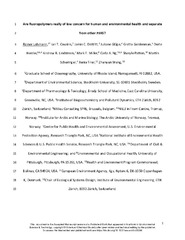Blar i forfatter "Cousins, Ian T."
-
Are Fluoropolymers Really of Low Concern for Human and Environmental Health and Separate from Other PFAS?
Lohmann, Rainer; Cousins, Ian T.; DeWitt, Jamie; Glüge, Juliane; Goldenman, Gretta; Herzke, Dorte; Lindstrom, Andrew B.; Miller, Mark F.; Ng, Carla A.; Patton, Sharyle; Scheringer, Martin; Trier, Xenia; Wang, Zhanyun (Journal article; Tidsskriftartikkel; Peer reviewed, 2020-10-12)Fluoropolymers are a group of polymers within the class of per- and polyfluoroalkyl substances (PFAS). The objective of this analysis is to evaluate the evidence regarding the environmental and human health impacts of fluoropolymers throughout their life cycle(s). Production of some fluoropolymers is intimately linked to the use and emissions of legacy and novel PFAS as polymer processing aids. There ... -
The high persistence of PFAS is sufficient for their management as a chemical class
Cousins, Ian T.; Dewitt, Jamie C.; Glüge, Juliane; Goldenman, Gretta; Herzke, Dorte; Lohmann, Rainer; Ng, Carla A.; Scheringer, Martin; Wang, Zhanyun (Journal article; Tidsskriftartikkel; Peer reviewed, 2020-10-29)Per- and polyfluoroalkyl substances (PFAS) are a class of synthetic organic substances with diverse structures, properties, uses, bioaccumulation potentials and toxicities. Despite this high diversity, all PFAS are alike in that they contain perfluoroalkyl moieties that are extremely resistant to environmental and metabolic degradation. The vast majority of PFAS are therefore either non-degradable ... -
Information Requirements under the Essential-Use Concept: PFAS Case Studies
Glüge, Juliane; London, Rachel; Cousins, Ian T.; Dewitt, Jamie; Goldenman, Gretta; Herzke, Dorte; Lohmann, Rainer; Miller, Mark; Ng, Carla A.; Patton, Sharyle; Trier, Xenia; Wang, Zhanyun; Scheringer, Martin (Journal article; Tidsskriftartikkel; Peer reviewed, 2021-10-05)Per- and polyfluoroalkyl substances (PFAS) are a class of substances for which there are widespread concerns about their extreme persistence in combination with toxic effects. It has been argued that PFAS should only be employed in those uses that are necessary for health or safety or are critical for the functioning of society and where no alternatives are available (“essential-use concept”). ... -
An overview of the uses of per- And polyfluoroalkyl substances (PFAS)
Glüge, Juliane; Scheringer, Martin; Cousins, Ian T.; Dewitt, Jamie C.; Goldenman, Gretta; Herzke, Dorte; Lohmann, Rainer; Ng, Carla A.; Trier, Xenia; Wang, Zhanyun (Journal article; Tidsskriftartikkel; Peer reviewed, 2020-10-30)Per- and polyfluoroalkyl substances (PFAS) are of concern because of their high persistence (or that of their degradation products) and their impacts on human and environmental health that are known or can be deduced from some well-studied PFAS. Currently, many different PFAS (on the order of several thousands) are used in a wide range of applications, and there is no comprehensive source of information ... -
Strategies for grouping per- and polyfluoroalkyl substances (PFAS) to protect human and environmental health
Cousins, Ian T.; DeWitt, Jamie C.; Glüge, Juliane; Goldenman, Gretta; Herzke, Dorte; Lohmann, Rainer; Miller, Mark; Ng, Carla A.; Scheringer, Martin; Vierke, Lena; Wang, Zhanyun (Journal article; Tidsskriftartikkel; Peer reviewed, 2020-06-04)Grouping strategies are needed for per- and polyfluoroalkyl substances (PFAS), in part, because it would be time and resource intensive to test and evaluate the more than 4700 PFAS on the global market on a chemical-by-chemical basis. In this paper we review various grouping strategies that could be used to inform actions on these chemicals and outline the motivations, advantages and disadvantages ...


 English
English norsk
norsk



